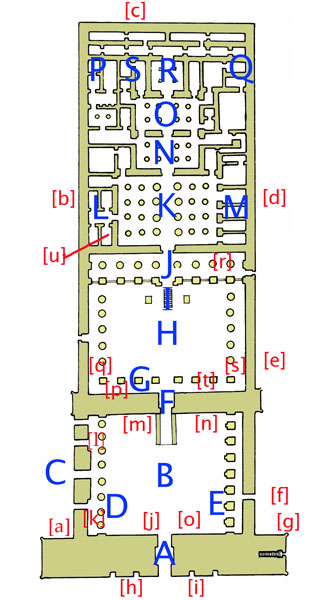 Architectural Features Architectural Features
A - First pylon
B - First courtyard
C - Window of the Appearances
D - Bell-shaped columns
E - Osiris pillars
F - Second pylon
G - Portico with Osiris pillars
H - Second courtyard
I - Ramp
J - Portico with Osiris pillars
K - Large hypostyle room
L - Royal treasure rooms
M - Chapels dedicated to various
deities and deified Ramesses
N - Second hypostyle room
O - Third hypostyle room
P - Chapel of Ramesses III
Q - Chapel of Re Harmakhis
R - Shrine of the sacred barque
of Amun
S - Chapels of Mut and Khonsu
Re-Harakhty and Amun-Re
Reliefs and Scenes
a - Hunting the wild bull
b - Religious calendar; text of regnal year
12
c - Ramesses' expedition in Upper Egypt
d - Naval battle against the Peoples of the
Sea
e - Ramesses III with prisoners and Philistines
f - Libyan wars
g - Destruction of the Hittite strongholds
h - Ramesses III ritual sacrifice of prisoners
before Re-Harakhty & Amun-Re
i - Ramesses III ritual sacrifice of prisoners
before Amun-Re & Ptah
j - Ramesses III defeats Libyans (text of regnal
year 2)
k - Ramesses III goes to the Beautiful Feast
of the Valley; military parade
l - Fight scenes and equestrian scenes
m - Ramesses III sacrifices the prisoners to
Amun and Mut
n - Upper register; offering to various deities;
lower register - battle scenes
o - Triumph of the pharaoh and parade of prisoners
p - Feast of Sokar
q - Counting of the hands and phalluses cut
from the enemy
r - Upper register - offering to deities; lower
register-representation of the sons of Ramesses III
s - Upper register - feast of Min; lower register
- procession of the barques of Amun, Mut and Khonsu
t - Ramesses III before a deity
-
u - Ramesses III makes offerings to Amun
Dimensions
Perimeter of enclosure - 1144m
Perimeter of temple of Ramesses III - 426m
Temple enclose - 305m long and 192m wide
1st pylon - width at base 10m and top 4, 60m
long
1st courtyard - 47m wide and 40 deep
2nd courtyard - 47m wide and 40 deep
Hypostyle rooms, rooms, chapels
rooms and shrines - 47m wide and 62 deep
Roman courtyard - 42m wide and
12m deep
"Small" temple - 12m wide, 106
long
During the 20th Dynasty, Djanet became
the administrative centre of Western Thebes and the meeting
place of the striking workers and artisans of Deir el-Medina who stayed
there waiting for their demands to be accepted.
Later, by the end of the 20th Dynasty, this site became a place of
refuge for the population during the war waged by the
High Priest of Amun of Karnak against the viceroy of Kush, and still
later, in the period of the 25th and 26th Dynasties,
it was the place where the cult of the Divine Adoratrices of Amun was
celebrated. The Medinet Habu complex was expanded
during the Graeco-Roman period, and its long history still continued
between the 1st - 9th centuries AD when the Coptic
city of Jeme was built in the area and a church was constructed in the
second courtyard of the Temple. The excavations of
Medinet Habu began in 1859 and, since 1924, studies at the site have
been carried out by the Oriental Institute of the University
of Chicago, which has published the complete epigraphical and
architectural documentation of the Temple.
|
- The Temple of Ramesses III
The Temple of Ramesses III is the best preserved among all temples of Thebes, and its decorated surfaces amount to 7,000
square meters. The structure of the Temple and its iconographic system are similar to those of the Ramesseum, although it
can hardly equal the elegance of its forms and the balance of dimensions. A unique feature of this Temple, that used to
be called in ancient times "the Temple of User-Maat-Re Meriamun Who Joins Eternity in the Possession of Amun in the West
of Thebes", is the presence on its eastern side, in front of the first pylon, of a tower built in the form of a Migdol (a
military fortress in Asia Minor) which gave the Temple the aspect of a fortress and had protective functions in the large
wall surrounding the Temple. On passing through the Migdol, one enters a vast space preceding the first pylon where, to
the left, one can see the funeral chapels of the Divine Adoratrices of Amun and, to the right, the Temple of Amun of the
18th Dynasty. The external lateral walls of the Temple are covered with important bas-reliefs; of particular interest among
them are those of the northern wall illustrating the battles fought by Ramesses III against the Peoples of the Sea. On the
southern wall, numerous liturgical festivities are listed and reproduced, as well as the economic resources of the Temple
necessary for its complex functioning and brought there from its numerous possessions donated to the Temple by the king
at the time of its inauguration. -
-

-
-
-
-
-
- The first pylon, on which one can see four large hollows intended to hold wooden poles from which
flew the divine insignia, is decorated with bas-reliefs showing Ramesses III in the process of ritual massacre of Asian
prisoners in front of Amun-Re (the southern tower) and Nubian and Libyan prisoners in front of Amun-Re-Harakhty (the northern
tower). On the south-western side of the pylon, one can see a brilliantly illustrated scene of bull-hunting in the marshes;
it is considered one of the artistic masterpieces of the 20th Dynasty.
-
- Having passed through the gigantic door of the first pylon, one enters the first courtyard, on
whose northern and southern sides are two porticos; the southern portico has an opening, the so-called "Window of Appearances"
connected to the royal palace situated outside. The dominant theme of the bas-reliefs in the first courtyard is represented
by the king's troops annihilating the enemy (the Libyans and the Peoples of the Sea) whom Ramesses fought during the 8th
year of his reign. On the walls are shown not only the vanquished enemies, who can be recognized by an exhibition of parts
of their bodies, but also the war booty, duly listed and quantified, together with the hands and sometimes the phalluses
which the Pharaoh's soldiers used to cut off the dead bodies of the vanquished enemies to show their own valour.
-
- The first courtyard is closed on the north by the second pylon, whose door leading to the second
courtyard. The second courtyard which was also referred to as the "Courtyard of the Feasts" is surrounded by a peristyle:
both porticos on the eastern and western sides are decorated with eight Osirian columns, while those to the north and south
are supported by large columns in the form of papyrus scrolls.
-
- At first, the decoration motifs continue the military themes characteristic of the preceding courtyard
(the eastern part of the southern portico) but, farther on, there are illustrations of great religious festivities dedicated
to Sokar-Osiris (southern portico) and to Min (northern portico). The wall of the western portico, from which a staircase
leads to the first hypostyle hall, is dedicated to the theme of royal power: in the northern part, the king is being purified
by Thoth and Horus, and, in the southern part, one can see the scene representing the Pharaoh's accession to the throne
where he is accompanied by Thoth in front of the Triad of Thebes. This wall also features the pictures of the sons of Ramesses
III, the future Ramesses IV, VI, VII, and VIII, whose images were added in succession as these princes acceded to the throne.
-
- The first hypostyle hall, of which
only the base of the 24 columns that supported the ceiling now
remain, has in its south-western part a complex of four rooms, evidently
intended to serve as treasury for the Temple, as
is proved by bas-reliefs on the walls representing heaps of gold, silver
and precious stones. Two more annexes situated
in the corner between the first and the second hypostyle halls were
intended to serve as sites for the cult of the god Montu
(the first) and as an additional treasury (the second). The northern
side of the hypostyle hall contained a group of five
contiguous halls, perpendicular to the axis of the Temple and dedicated
to various divinities. Moving towards the West,
one enters the second hypostyle hall supported by eight columns, with
two groups of lateral halls annexed: those situated
in the southern part were dedicated to the Osiris cult of the deified
king, while those in the north were dedicated to various
solar gods, among whom the dominant role belonged to Re-Harakhty with
whom the king was identified in his celestial resurrection.
Then follows the third hypostyle hall whose structure is identical to the previous one and whose lateral chapels are dedicated
to various gods: Horus and Mut in the south, Amun-Re, the Ennead of Heliopolis, Min, Mut, and Khonsu in the north.
|
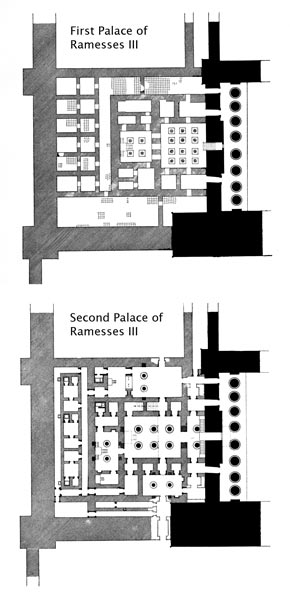 The Royal Palace The Royal Palace
- In the southern part of the Temple grounds, one can clearly see, within the space between the first
and the second pylons, the foundation of the Royal Palace that was built in two successive construction stages. The Royal
Palace was directly connected with the first courtyard of the Temple via the "Window of Appearances" through which the pharaoh
made his public appearances. However, it is not known for certain whether the Royal Palace was in fact only a symbolic and
ritual construction or whether it was indeed used by the Pharaoh when he travelled to the western bank to preside over the
most important religious ceremonies.
The Saite chapels of the Divine Adoratrices of Amun
-
The funeral chapels of the Divine Adoratrices of Amun are situated in a small building in the south-eastern part of
the space preceding the first pylon. In the course of the Intermediate Period and in the period of the 25th and the 26th
Dynasties, certain Divine Adoratrices of Amun were worshiped. The Divine Adoratrices of Amun ruled upper Egypt, at least
nominally, on behalf of the King during this period of Egyptian history.
-
- These were the royal princesses and princes enjoying great prestige and representing the King in
the area around Thebes - such as Amenirdas (sister of Shabago), Shepenwepet (daughter of Osorkon III) and Nitokris (daughter
of Psamtek I) were all buried within the Ramesseum.
-
- The southerly chapel of Amenirdas is the best preserved and has a forecourt with an offering table,
a inner and mortuary chapel - beneath which the Adoratrices was buried in a crypt. Above the entrances to the chapels is
an "Appeal to the Living" which encourages passers-by to say an offering for the spirits of the Divine Adoratrices.
- The Temple of the 18th Dynasty
To the north of the principal Temple of Ramesses III stands the Temple of the 18th Dynasty dedicated to Amun by Hatshepsut
and Tuthmosis III. This original building was repeatedly enlarged and modified up to the Ptolemaic and Roman periods.
-
- Numerous decorated blocks which originated from the Temple of Tuya and Nefertari, adjacent to the
Ramesseum, were added to the building in the course of the 29th Dynasty, during the reign of Achoris; the eastern pylon,
however, was added in the Ptolemaic period, while the courtyard and the structures preceding it were included during the
Roman period.
-
- Directly to the north of the Temple there are the remnants of the Sacred Lake, a symbolic representation
of the primordial waters, and further to the west, a Nilometer.
-
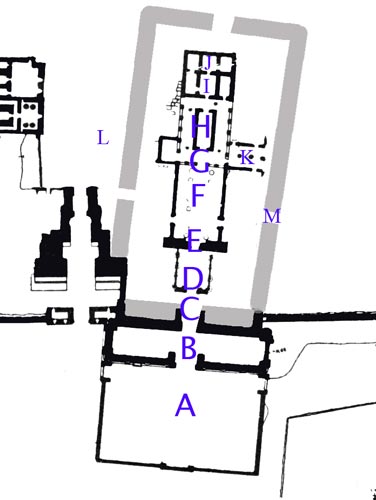
- Architectural Features
- A - Roman courtyard
- B - Roman portico
- C - Ptolemaic pylon
- D - Colonnade of Nectanebo
E - Pylon of Shabago
- F - Courtyard with columns
- G - Peristyle
- H - Chapel of Hatshepsut and Tuthmosis III
- I - Chapel, Naos in pink granite
J - Shrine
K - Room of Achoris
L - Door of Nectanebo
- M - Door of Taharqa
-
- Sources:
- The Complete Temples of Ancient Egypt; Richard Wilkinson; Thames & Hudson
- Guide to the Valley of the Kings & Theban Necropolises; Albert Siliotti; Gaddis & Sons
- Luxor; Longman; Jill Kamil
- Historical records of Ramses III: Texts in Medinet Habu; James Breasted & George Allen
|
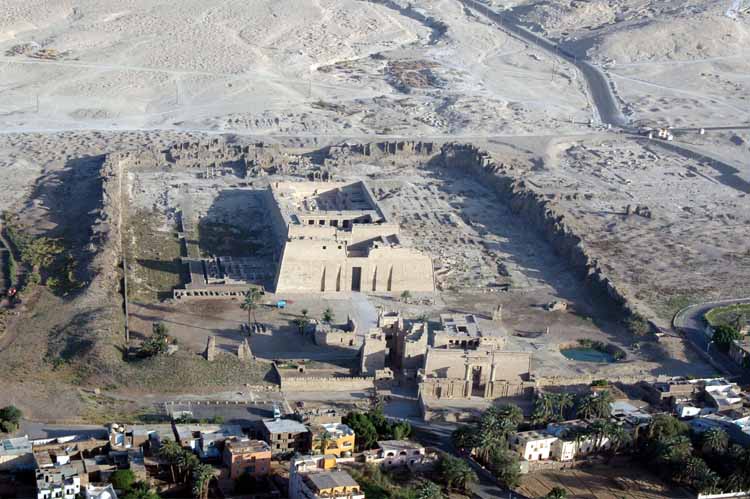
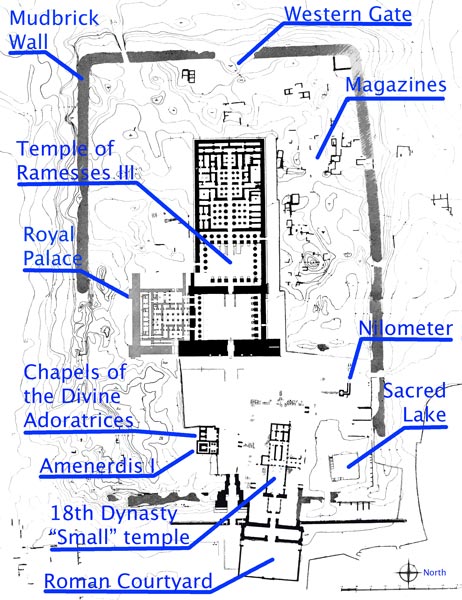 Medinet Habu, a small village
situated a little over two kilometres to the south of the Ramesseum, was called Djanet by the ancient Egyptians and, according
to popular belief, it was the place where Amun appeared for the first time. From ancient times, it was the place of worship
dedicated to this god, as evidenced by the existence in this place of a temple of the 18th Dynasty dedicated to Amun
of Djanet, built during the time of Hatshepsut and Tuthmosis III, probably on the ruins of a still more ancient temple;
this was what later induced Ramesses III to order the construction there of his own memorial temple.
Medinet Habu, a small village
situated a little over two kilometres to the south of the Ramesseum, was called Djanet by the ancient Egyptians and, according
to popular belief, it was the place where Amun appeared for the first time. From ancient times, it was the place of worship
dedicated to this god, as evidenced by the existence in this place of a temple of the 18th Dynasty dedicated to Amun
of Djanet, built during the time of Hatshepsut and Tuthmosis III, probably on the ruins of a still more ancient temple;
this was what later induced Ramesses III to order the construction there of his own memorial temple.

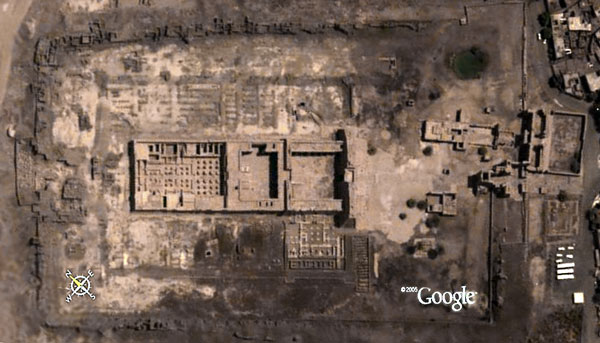



تعليقات
إرسال تعليق